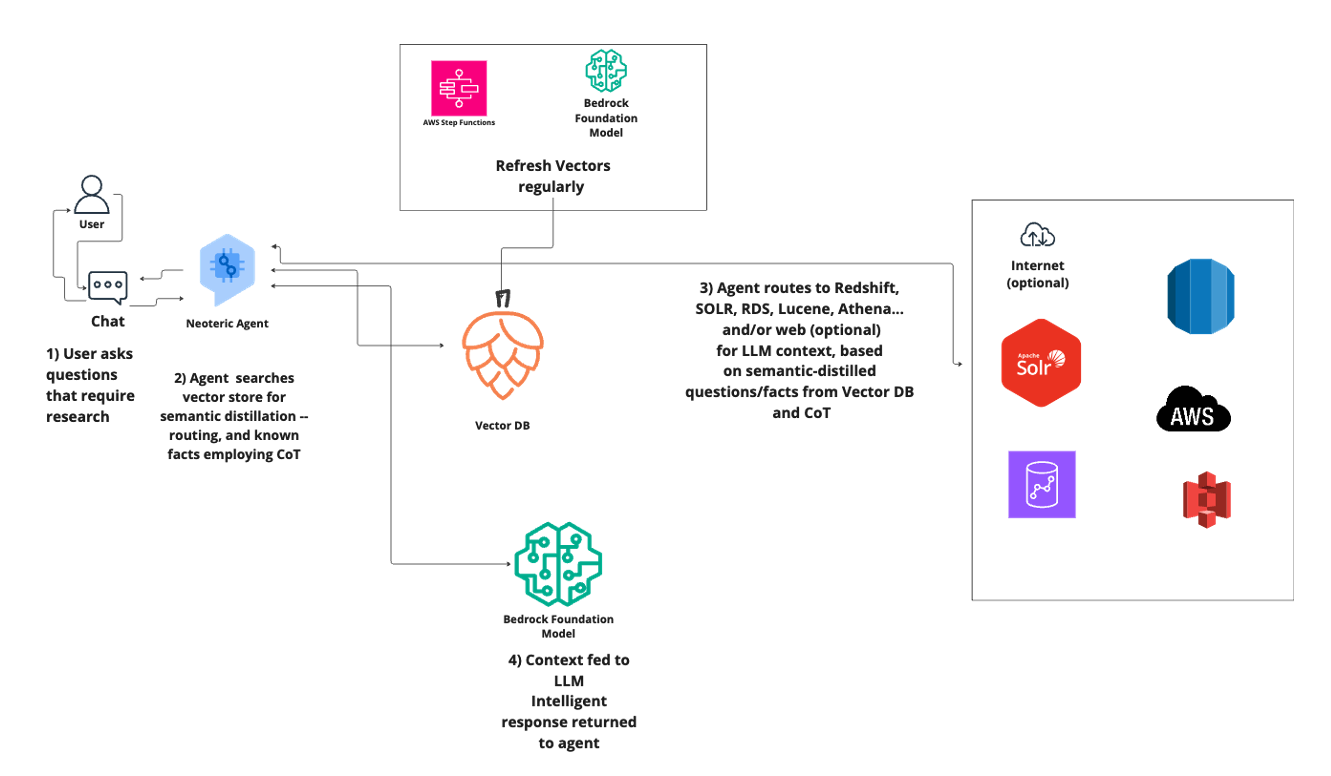Blog
Ragnarock: Merging the Reliability of Established Systems with Modern AI
RAG is Retrieval Augmented Generation
NA is Neoteric Agent
ROCK is short for Bedrock

Introduction
The world of software has seen continuous evolution, with modern advancements such as large language models (LLMs) and generative AI reshaping the landscape. As organizations look toward these new horizons, there remains a sizable investment in traditional systems – be it relational databases, CRM systems, Knowledge Management Systems, or Business Intelligence platforms. The key challenge for many is how to bridge the gap between the old and the new, to merge the reliability of established systems with the promise of modern AI technologies. Our proposal: the Ragnarock approach.
Problem Statement
Large Language Models are captivating due to their inherent capabilities, but they are also fundamentally stochastic. This randomness, while providing a vast scope of potential outputs, introduces an inherent risk when considering their deployment in trusted, critical software engineering tasks. Ensuring the accuracy, reliability, and consistency of outputs is vital, especially in production environments. The question then arises: how can organizations make use of the immense potential of LLMs without compromising on the integrity and repeatability of their software processes?
Solution: The Ragnarock Pattern
The Ragnarock pattern emerges as a promising solution to this dilemma. At its core, Ragnarock is designed to act as a bridge, seamlessly connecting traditional systems with modern LLMs. By overlaying the capabilities of LLMs onto existing infrastructures, we are not only preserving the investments already made in traditional systems but are also enhancing their potential with the capabilities of generative AI.
The architecture is built around the principle of "semantic distillation", which involves extracting and translating knowledge from one format into another, ensuring that the essence or meaning of the information remains intact. In this context, it implies that the stochastic nature of LLMs is "distilled" in such a manner that their outputs become more predictable, accurate, and in line with the standards required for production-grade software. One of the exciting possibilities of LLMs is the ability to generate semantically similar structures. As such, the stochastic vulnerabilities of LLMs can also be used as an asset.
Why Bedrock
Amazon Bedrock is a fully managed service that offers a choice of high-performing foundation models (FMs) from leading AI companies like AI21 Labs, Anthropic, Cohere, Meta, Stability AI, and Amazon with a single API, along with a broad set of capabilities developers need to build generative AI applications, simplifying development while maintaining privacy and security.
With the comprehensive capabilities of Amazon Bedrock, developers can easily experiment with a variety of top FMs, privately customize them with an organization’s proprietary data using techniques such as fine-tuning and retrieval augmented generation (RAG), and create managed agents that execute complex business tasks.
Since Amazon Bedrock is serverless, there is no need to manage any infrastructure, and developers can securely integrate and deploy generative AI capabilities into applications using the familiar AWS services.
Benefits of Ragnarock
- Preservation of Investment: With the Ragnarock pattern, organizations don't have to render their previous investments obsolete. Instead of facing the costly and time-consuming task of replacing existing systems immediately, they can augment their current infrastructure. This means that all the resources, time, and effort previously poured into developing and maintaining traditional systems are not wasted. This synergy between the old and the new ensures a smoother transition phase and maintains operational continuity.
- Reduced Risk: Introducing new technologies often comes with a spectrum of uncertainties. LLMs, due to their stochastic nature, can pose significant challenges in terms of consistency and reliability. The Ragnarock pattern, through its semantic distillation methodologies, curbs this unpredictability. By refining the outputs of LLMs, it ensures that the results align more closely with enterprise expectations and standards, thus alleviating concerns about potential inaccuracies or anomalies.
- Cost-Efficient Innovation: Embracing new technologies often comes with a significant price tag. However, Ragnarock offers a pathway to integrate advanced Generative AI into existing frameworks without the substantial costs associated with ground-up implementations. This economically efficient approach ensures organizations can remain at the forefront of technological innovation without straining their budgets.
- Enhanced System Capabilities: While traditional systems have their strengths, they often operate within defined boundaries. By integrating LLMs through the Ragnarock pattern, these systems can be supercharged to perform tasks beyond their original design, from advanced data analytics to sophisticated pattern recognition. This integration opens doors to new functionalities and possibilities.
- Flexibility and Scalability: As organizations grow and their needs evolve, having a flexible and scalable architecture becomes paramount. Ragnarock, with its agent-based design, provides a modular approach. This modularity means components can be added, removed, or updated without overhauling the entire system. This adaptability ensures that organizations can respond swiftly to changing demands or market conditions.
- Future-Proofing: Technology landscapes are in constant flux, and what's cutting-edge today might become outdated tomorrow. Ragnarock's architecture is designed with the future in mind. Its inherent ability to integrate with both traditional systems and advanced AI models ensures that organizations adopting this pattern will remain resilient and adaptive to future technological shifts.
- Unified Knowledge Base: Traditional systems, ranging from CRMs to Knowledge Management Systems, often function in silos. Ragnarock serves as a unifying layer, seamlessly integrating diverse data sources and systems. This integration fosters a more holistic view of organizational data, leading to better insights and decision-making.
Conclusion
As the software landscape continues its relentless evolution, the key to success lies in harmonizing the old with the new. Ragnarock offers a strategic blueprint for organizations to harness the power of Large Language Models without leaving behind their legacy systems. In an era where innovation is as much about intelligent preservation as it is about pioneering breakthroughs, the Ragnarock pattern emerges as a beacon for forward-thinking enterprises.
The Ragnarock Pattern
References
- Structural and Statistical Texture Knowledge Distillation for Semantic Segmentation https://arxiv.org/pdf/2305.03944.pdf
- Knowledge Distillation of Large Language Models
https://arxiv.org/pdf/2306.08543.pdf - AgentTuning: Enabling Generalized Agent Abilities for LLMs
https://huggingface.co/papers/2310.12823 - The Research Agent: Addressing the Challenge of Answering Questions Based on a Large Text Corpus
https://towardsdatascience.com/the-research-agent-4ef8e6f1b741 - Langchain Agents with Bedrock
https://python.langchain.com/docs/integrations/llms/bedrock
Author Spotlight:
Max K Goff
Keep Up To Date With AWS News
Stay up to date with the latest AWS services, latest architecture, cloud-native solutions and more.
Related Blog Posts
Category:
Category:
Category:


